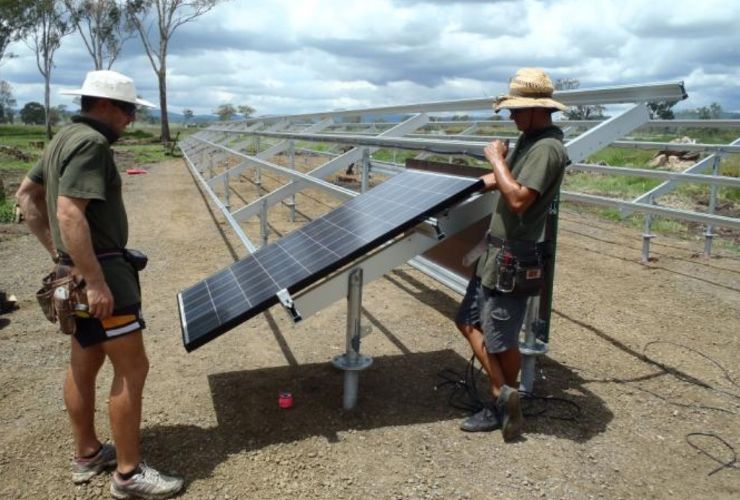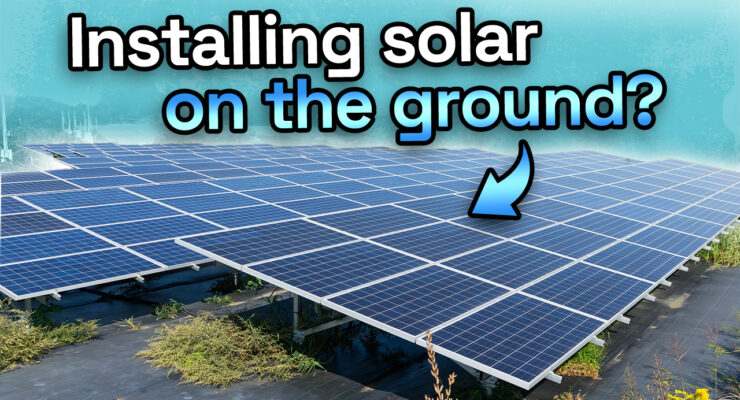Fast read
Installed on the ground, ground-mounted solar systems can be positioned wherever there is enough room and sunshine is available.
Standard systems, which are supported by ground anchors and hold the panels in a fixed position, and pole mount systems, which contain a single or multi-axis tracking system and are supported by a pole, are the two primary categories of ground-mounted systems.
Because of their ideal location and angle, ground-mounted systems, which can cost between $15,000 and $40,000, can generate more electricity than roof-mounted systems.
What can you do if you don’t have any roof space?
When someone mentions solar systems in conversation, your mind probably thinks about them on top of a roof. However, the majority of solar panels in the world are installed on the ground. These ground mounted solar systems are precisely what the name suggests – a solar system mounted on the ground. You can install these systems anywhere with sufficient space and sunlight absorption, including mountainous regions and sloping grounds.
The different types of ground mounted solar systems
Standard ground mounted system
The most common method of installing ground mounted solar panel systems is to use ground anchors to hold up the racking table that supports the solar panels on rails. The ground anchors are usually concrete piers but can also be concrete ballasts, driven piers, or helical piles.
Pole mount
A pole mount system requires digging a single large hole and pouring a concrete foundation into the ground. This foundation secures a pole, to which you connect the rails and mount your solar panels. The main difference is that this type of installation only has one large hole, while the standard installation method requires several smaller holes.
This style of ground mounted system has the benefit of having a higher clearance from the ground, which can limit the debris that gets onto the solar panels. Another benefit is that this type can have a single or dual-axis tracking system, which allows the panel to follow the sun throughout the day. This allows the solar panels to generate higher daily output.

How much does a ground mounted system cost?
Having ample space around your home and considering solar panels unattractive on a roof, a residential application can opt for a ground mounted solar panel system installation.
The cost of a ground mounted solar system can range from $15,000 to around $40,000 for residential systems depending on the size of the system. This is more expensive than traditional roof solar systems due to the more intensive labour and installation process.
For some rooftop installations, the installer can install the racking and solar panels immediately, with minimal extra work needed. Even if you have the perfect location for a ground mounted system, the installer still needs to create the foundations for the system to sit in and install the rails and solar panels.
What is the main benefit?
A ground mounted solar panel system’s greatest advantage over a rooftop system is the increased control over the system’s location, direction, and installation angle. They also usually produce a little more electricity than a roof-mounted system in the same location because the more direct sunlight your solar panels have, the higher their output will be.
If you opt for rooftop solar, you do not have much freedom. You have to put them on your roof, meaning the direction the solar panels face and the angle they are on is pre-determined and cannot be altered. You may also have skylights and other obstacles, such as trees shading your roof. These obstacles can reduce electricity generation. A specific roof space can also limit the number of panels you can have, while the ground usually has more space than your roof.
Alternatively, with a ground mounted system, you have the freedom to select the panel orientation, the optimal location, and the installation angle. This can lead to a higher return on your investment, as the output will increase due to the beneficial location of the solar panels.

What is the main disadvantage of ground mounted solar panel systems?
The main drawback of having your solar system ground mounted is the space it takes up. Unless you have a massive backyard or own extra land, the solar panels will occupy much of your backyard space. This can be annoying if you have pets or children; they need that space to play around and get outside.
Having solar panels take up most of your outdoor space also affects the aesthetic of your home. I am sure most people can agree solar panels are not the best-looking feature to add to your home, so putting them on the ground for everyone to see compared to on your roof for no one to see is a trade-off you must consider.
Installing a ground mounted solar system is definitely an option worth looking into if you are in the region, for example, on a farm where you need a bigger system than your roof can accommodate.
Ground mounted solar panel systems are a great option if the major benefits outweigh the disadvantages.



